Louis Menand reports in The New Yorker:
The rise of personality testing in the twentieth century was a response to an increase in the number of office workers. You do not need a test to figure out who should milk the cow, but you want to have a method of distinguishing salespeople from managers. Human-resource science developed as a way of maximizing corporate employees. There are more than two thousand personality tests on the market, but Myers-Briggs is No. 1.Your browser already knows what kind of person you are a thousand times more intimately than any test will ever reveal.
There are two kinds of people in the world: people who think there are two kinds of people in the world and people who don’t. Katharine Briggs and Isabel Myers were the first kind, and the test they invented based on that belief, the Myers-Briggs Type Indicator, or MBTI, is the most popular personality test in the world. More than two million people take it every year. It is used in twenty-six countries to assess employees, students, soldiers, and potential marriage partners. It is used by Fortune 500 companies and universities, in self-improvement seminars and wellness retreats. There are more than two thousand personality tests on the market, many of them blatant knockoffs of the MBTI, but Myers-Briggs is No. 1. Merve Emre’s “The Personality Brokers” (Doubleday) is the story of how the MBTI fell to earth.
It was a long descent. Briggs and Myers were a mother-and-daughter team. To call them “mildly eccentric” would be indulging in a gender stereotype, but it seems fair to say that they were a little O.C.D. They devoted their lives to their system, and they kept the faith for a very long time. If they had not, there would be no MBTI today.
The mother, Katharine Cook Briggs, was born in 1875. When she died, in 1968, the test she inspired was all but forgotten. The daughter, Isabel Briggs Myers, was born in 1897. She codified her mother’s method of categorizing personalities, copyrighted it (in 1943), and spent the rest of her life trying to find a permanent home for the product. She died in 1980, just as the test’s popularity was taking off.
Since Katharine began studying personality differences when Isabel was four, this means that the two women persisted for almost eighty years before the MBTI became the commercial bonanza it is today. According to Emre, personality testing has become a two-billion-dollar industry. But Briggs and Myers were not in the personality game for the money. They truly believed that they had discovered a way to make work more efficient and human beings less unhappy.
Emre’s book follows closely the account of the development of the MBTI given in Annie Murphy Paul’s “The Cult of Personality Testing,” published in 2004 (a work that Emre surprisingly does not acknowledge). Both books describe Briggs and Myers as intellectually driven women in an era when career opportunities for intellectually driven women were slim. Neither one had any training in psychology or in psychiatry—or, for that matter, in testing—and neither ever worked in a laboratory or an academic institution. A third woman, Mary McCaulley, who came upon the test in 1968, the year Katharine died, was a professor of psychology at the University of Florida. She teamed up with Isabel, and was indispensable in turning the MBTI into a professional operation. But, essentially, the MBTI was home-cooked.It arose out of one of the most mundane domestic circumstances—the fact that the members of a family often differ in tiny but stubbornly irreducible ways. One spouse is a planner and the other is spur of the moment. One child has a million friends and another child is a loner. In the home, differences like these are magnified, because people are less self-conscious and because enforced intimacy generates friction. But at work, too, people have noticeably divergent ways of operating.
Sibling and spousal differences are the kind of thing that might attract the interest of a housewife deprived of other ways to exercise her brain, and that’s what happened with Katharine Briggs. The key to the MBTI’s success is her insight that you can waste a lot of energy and bring on a lot of psychic pain if you think of these differences as incompatibilities that have to be ironed out. The differences are innate, and each type of personality is as “normal” as the others. There is no better way to be—logical or emotional, spontaneous or organized, party bro or brooder. These are not imperfections to be corrected. They are hardwired dispositions to be recognized and accommodated.
In the workplace, this means assigning tasks to people based on their personality types, which is one of the things that the MBTI is supposed to help companies do. (Emre says that the office-furniture designer Herman Miller uses a modified version of the MBTI to create chairs and desks for different personalities.) In life, it means recognizing that we are naturally more likely to get along with some people than with others, and that when people aren’t communicating it can simply be because they are broadcasting on different frequencies. We need to get used to it.The MBTI folks therefore do not refer to their device—a ninety-three-item, a-or-b format questionnaire that subjects are not supposed to take a lot of time filling out—as a “test.” The MBTI is not something you can pass or fail. The MBTI is an “indicator,” and what it is meant to indicate is the type of personality you have been born with.The theory behind the MBTI, actually, is not that there are two kinds of people in the world. It’s that there are sixteen kinds of people in the world, but that each personality type reduces to a set of elements taken from four either/or binaries. Everyone is either extroverted or introverted, sensing (meaning relying on sense data) or intuitive, thinking or feeling, judging or perceiving.
Your “score” on the test is the combination of the four characteristics indicated by your answers to the ninety-three questions, which ask such things as “In reading for pleasure, do you (a) Enjoy odd or original ways of saying things; or (b) Like writers to say exactly what they mean?” (It’s unclear why these are mutually exclusive alternatives.) Using an initial for each characteristic, with N standing
for intuition, you can be scored an ESTJ, an INFP, or one of the remaining fourteen four-letter combinations. Emre says that using this initial shorthand is called “speaking type.”
The MBTI is different from other tests with high name recognition, like the Minnesota Multiphasic Personality Inventory (MMPI)—first published in 1943, the year Myers copyrighted the MBTI—because the MMPI is used in the diagnosis of psychiatric disorders, and the Myers-Briggs test is a human-resources technology, a nonjudgmental way of people-sorting. It is not designed to pick out the neurotics.
But the MBTI is also promoted as a means of self-discovery, and that is undoubtedly why it is so widely used today. The company that took ownership of the test in 1975 and now administers it, CPP, Inc., advertises learning your personality type as a potentially life-changing experience. Emre reports people telling her that they felt liberated after finding out their type, that it helped them cope with their work or with their marriage, that it empowered them to be themselves. (Emre participated in a training program for MBTI certification and does not report feeling liberated after taking the test, although that may be because she tried to sabotage her session by parodying back at her trainers the kind of language they were using. She was denied access to the Myers Briggs archives—not an ideal outcome for someone writing a book on the subject.)
Emre is an English professor at Oxford, and she began her research with an English professor’s skepticism about quantitative social science and “technologies of the self.” She brings in Bentham and Foucault to suggest the MBTI’s connection to regimes of surveillance and control. She refers to Stanley Milgram (of the “obedience to authority” experiment) and Philip Zimbardo (of the Stanford prison experiment), to remind us that scientistic nomenclature can shape behavior in troubling ways. She refers to William Whyte’s “The Organization Man,” published in 1956, as a way of associating the MBTI with a postwar culture of conformity. (Like a lot of people, she mistakenly calls Whyte a sociologist. Whyte was a magazine writer; he worked at Fortune. He was no more a social scientist than Briggs and Myers were.)
She also associates the MBTI with mid-century schemes to organize and manipulate people by reducing them to numbers. The Scholastic Aptitude Test, first widely administered by the Educational Testing Service, is a classic example. The SAT-1 is essentially an I.Q. test: it translates individual mental ability into a pair of numbers that can have life-defining consequences. In fact, in the late nineteen-fifties and early nineteen-sixties, Myers worked closely with the E.T.S., whose director, Henry Chauncey, a people-sorting fanatic, wanted to get the company into what he called “non-cognitive” areas of assessment.All this is the wrong context for the MBTI, though. The idea that human beings can be sorted into psychological types is ancient, of course. In the Hippocratic tradition, people could be categorized as innately sanguine, choleric, melancholic, or phlegmatic. (For melancholics, white wine was prescribed, to counteract the black bile.) In nineteenth-century Europe and America, phrenology was used to interpret character.
Systematic personality testing, though, is a twentieth-century thing. Annie Murphy Paul considers the Rorschach test, which was created in 1921, the first such device. In the case of the MBTI, three of the four binaries that the test uses were derived from Carl Jung’s book “Psychological Types,” also published in 1921. (Briggs had developed her own categories, but after reading Jung’s book she swapped out her terms for his. She also seems to have developed a long-distance crush and become a kind of Jung groupie.) The E.T.S. opened in 1947. By then, there were hundreds of personality tests on the market and hundreds of psychology consulting firms in business to administer them. According to Whyte, by 1952 a third of American companies were using personality tests.
But most of them were not using the MBTI. And that is because—as the E.T.S. finally concluded after pouring a lot of money into it—the MBTI is not a scientific instrument. Paul lists some of the criticisms of it made by the testing experts. More than half the people who take it a second time get a different score. Even the test-makers thought that it didn’t work for everyone. (As Myers put it: “The type differences show principally in the more intelligent and highly developed half of the population.”) And, in the aggregate, the results are insufficiently bimodal—that is, most test-takers fall between the binaries, neither extroverted nor introverted (as, after all, one would expect).
Most significant, the test is entirely self-reported. If you say you are extroverted, that is what the indicator believes. The system leaves no room for one of the most basic human capacities, the capacity for self-deception. Even the parlor game in which people characterize their friends as horses, birds, or muffins allows for false consciousness—for birds who think they are horses, or muffins who think they are birds (as most muffins do).
We might assume that the MBTI has workplace payoffs, since businesses apparently continue to pay for it. McKinsey, the corporate consulting firm, is said to use it in its own operations. But Paul, who is as skeptical as Emre, says that “there is scant evidence that MBTI results are useful in determining managerial effectiveness, helping to build teams, providing career counseling, enhancing insight into self or others, or any other of the myriad uses for which it is promoted.”
And it’s not easy to see how the different types correlate with different tasks. Here is how ENFPs (that is, people who are extroverted, intuitive, feeling, and perceiving) are described on the test’s official Web site, MBTIonline.com:
Enthusiastic innovators, always seeing new possibilities in the world around them. Their world is full of possible projects or interests they want to pursue. Imaginative, high spirited, and ingenious, they are often able to do almost anything that interests them. They are confident, spontaneous, and flexible, and often rely on their ability to improvise.Here is a description of a personality type found on a different Web site:
They value home, family, friendships, creativity, and learning.
Shy and quiet, but on the other hand they can be eccentric and energetic. However, in both cases, they are deep thinkers and highly intellectual people who love helping others. They are able to see without prejudice, on both sides, which makes them people who can easily solve problems. Although they can easily adapt to the energy that surrounds them, they have a deep need to be some time alone and away from everything, in order to restore power. They look at the world as a place full of possibilities.That one is from astrology-zodiac-signs.com. It describes Aquarians.Whom do descriptions like these most appeal to? Not to employers. To people looking for employment. The rise of personality testing in the twentieth century was a response to an increase in the number of office workers. In 1900, eighteen per cent of American workers had white-collar jobs and thirty-seven per cent worked on farms; in 1950, thirty-seven per cent were office workers and twelve per cent were farmers. You do not need a test to figure out who should milk the cow, but you might want to have a method of distinguishing your salespeople from your managers. Human-resource science, of which personality testing is a part, developed as a way of maximizing the potential of corporate employees.
In this context, the scientific inadequacies of the MBTI made it a marginal player in the mid-century H.R. world. A test that asks you what kind of book you like to read does not present itself as an incisive instrument of assessment. But when the work world becomes fluid and uncertain, as happened in the United States after 1970—with people losing their jobs, people “retooling,” people moving from one kind of job to another—an instrument for taking stock of one’s personal interests and abilities is appealing. The MBTI is a “What Color Is Your Parachute?” device.
This use of personality testing is beautifully consistent with the bottom-up origins of the MBTI. It’s a motherly employment agency,
a gentle way of helping people orient themselves in a confusing world. It doesn’t belong with Michel Foucault and Stanley Milgram. It belongs with books like “I’m OK, You’re OK” and “Games People Play,” works of popular psychology that gave readers schemes for identifying the kind of person they are.
Emre wants to give the MBTI her most sympathetic attention, but, in the end, she calls the test “among the silliest, shallowest products of late capitalism.” The sympathy comes, she explains, from relating, as a mother, to two women’s earnest attempt to extrapolate a theory of personality from their domestic observations. The dismissiveness comes partly from having been stonewalled by the Myers-Briggs people, and partly from distrust of the whole idea of tests and types and human-sorting. She also doesn’t like the idea that people should have to commodify their personal traits in order to find work.
One can find fault with the MBTI, and no doubt with many personality-assessment mechanisms. But there is no escaping types. We freely diagnose people all the time—as extroverts or narcissists, as “on the spectrum” or (for example) “a little O.C.D.” We hardly know the clinical definitions of terms like these, but a lot of interpersonal relations are navigated with their assistance.
As for tests, professors are the last people who should object to society’s people-sorting operations. People-sorting is what educational systems do. The process is much more fine-grained than a ninety-three-item questionnaire, but that’s why college is so expensive. It provides employers with a dossier that sums up a graduate’s aptitude and potential in a few pages and numbers, with two or three Latin words maybe added on.
And, like the MBTI, education helps people discover who they are—what they like doing, what they’re good at. To the extent that graduates then list these traits in their job-application letters, they are commodifying their personalities, it’s true. But personal qualities have value in service and information economies. As for surveillance regimes: your browser already knows what kind of person you are a thousand times more intimately than any test will ever reveal. ♦

























0 comments:
Post a Comment